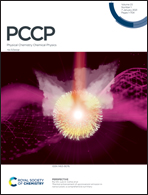Gate tunable self-powered few-layer black phosphorus broadband photodetector†
Abstract
Utilizing the unique gate induced giant stark effect in few-layer black phosphorus (BP), we theoretically propose a broadband photodetector device based on pure few-layer BP using atomic first-principles calculations. By applying a vertical gate voltage in the few-layer BP, the intrinsic inversion symmetry of the system can be broken. We found that the photocurrent can be generated via the photogalvanic (or photovoltaic) effect (PGE) without the need for an external bias voltage, which means the gated few-layer BP photodetector is self-powered and the dark current can be greatly suppressed. Most importantly, due to the giant stark effect of the gated few-layer BP, the photodetection range can be well controlled and further enlarged from the mid-infrared range (MIR) to the far-infrared range (FIR). Furthermore, the few-layer BP based photodetector device also presents high polarization sensitivity with extinction ratios up to 104 and a large anisotropic photoresponse. Our numerical findings pave a feasible way for the few-layer BP's novel application in self-powered and well-controlled broadband photodetectors.



 Please wait while we load your content...
Please wait while we load your content...